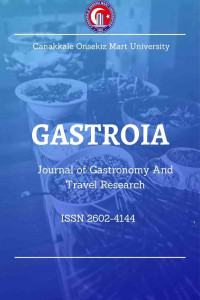Sustainable Cultural Heritage Management: Example of Troy Archaeological Site
Sustainable Cultural Heritage Management: Example of Troy Archaeological Site
Sustainability, cultural heritage Troy, administration,
___
- References Aksoy, A. & Ünsal, D. (2012). Kültürel miras yönetimi. Eskisehir: Açıkögretim fakültesi yayınları.Aslan, R. (2016).Homeros, İlyada ve Troya. İstanbul: E Yayınları.Bozlagan, R. (2005). Sürdürülebilir gelişme düşüncesinin tarihsel arka planı. Sosyal Siyaset Konferansları Dergisi, 40, 1012-1028.Daifuku, H. (1968). The significance of cultural property, The conservation of cultural property. Unesco, Paris, 19-27.Demirayak, F. (2006). Türkiye’de korunan alanlar için yeni bir yaklaşım (unpublished doctorate thesis). Ankara Üniversitesi Sosyal Bilimler Enstitüsü, Ankara.Günes, G. (2011). Korunan alanların yönetiminde yeni bir yaklaşım: katılımcı yönetim planları, Ekonomi Bilimleri Dergisi, 3 (1), 47-57.Güngör, H.F. (2018, May 3). Toplum için kültürel mirasın değeri konvansiyonu. Retrieved from http://www.europanostra.org.tr/files/file/Farokonvansiyonu.pdf ICOMOS Türkiye mimari mirası koruma bildirgesi (2018, May 3). Retrieved from http://www.icomos.org.tr/Dosyalar/ICOMOSTR_0623153001387886624.pdf İSMEP (2014), Kültürel mirasın korunması, İstanbul.Keles, R. & Hamamcı, C. (2005). Çevre politikası, Ankara: İmge Yayınevi.Kültür ve Turizm Bakanlığı (2018) Kültür ve Turizm Yılı Kitapçığı.Köksal, G. (2017). Kentsel koruma: kim için, neden, nasıl..?. In Uğurlu et al. (Ed.), Türkiye perspektifinden kent sosyolojisi çalışmaları, (pp. 343-373). İstanbul: Örgün Yayınevi.Ortak Geleceğimiz Raporu (1987). Ankara: Türkiye Çevre Sorunları Vakfı Yayını.Rojas, E. (2013). Sustainable preservation and development of the urban heritage. Culture: key to sustainable development The Hangzhou international congress Hangzhou, China, 14-17 May 2013.Thomas, et al., (2003). Guidelines for management planning of protected areas, Glan: The World Conservation Union.Türkiye Barolar Birliği, (2014). Uluslararası çevre koruma sözleşmeleri, 2.nd edition, Ankara. UNESCO (2018, May 1 ). Dünya mirası konvansiyonunun uygulanmasına yönelik işlevsel ilkeler. Retrieved from http://www.alanbaskanligi.gov.tr/files/Uygulama%20Rehberi.pdf 2863 sayılı kültür ve tabiat varlıklarını koruma kanunu.http://www.unesco.org/new/en/culture/themes/armed-conflict-and-heritage/convention-and-protocols/1954-hague-convention/ (accessed 10/03/2018)http://www.icomos.org.tr/Dosyalar/ICOMOSTR_0612886001496825607.pdf (accessed 11/03/2018)http://www.kulturvarliklari.gov.tr/TR,44423/dunya-miras-listesi.html) (accessed 10/03/2018)
- ISSN: 2602-4144
- Yayın Aralığı: Yılda 2 Sayı
- Başlangıç: 2017
- Yayıncı: Çanakkale Onsekiz Mart Üniversitesi
Sustainable Cultural Heritage Management: Example of Troy Archaeological Site
Melike ERDOĞAN, Şermin ATAK ÇOBANOĞLU
ATİNA’DA NE OLDU? ‘PRİAMOS HAZİNELERİ’ VE OSMANLI DEVLETİ’NİN TUTUMU
Troya Ören Yeri'nin Destinasyon Kişiliği
Oğuzhan DÜLGAROĞLU, Lütfi ATAY
Karma Gerçeklikli Görsel Müze Olarak Troya Müzesinin Karma Görsellik Yöntemi ile İncelenmesi
Truva’nın Ortaçağa Entelektüel Mirası: Bizans Kültür Hayatının Yapıtaşı Olarak Homeros
Troya (Truva) Millî Parkında Osmanlı Arkeolojisi
Antik Çağın Turizm Merkezi Olarak Troia
Serdar SÜNNETÇİOĞLU, Ayşe SÜNNETÇİOĞLU, Ferah ÖZKÖK, Ümit ÇARBUĞA
